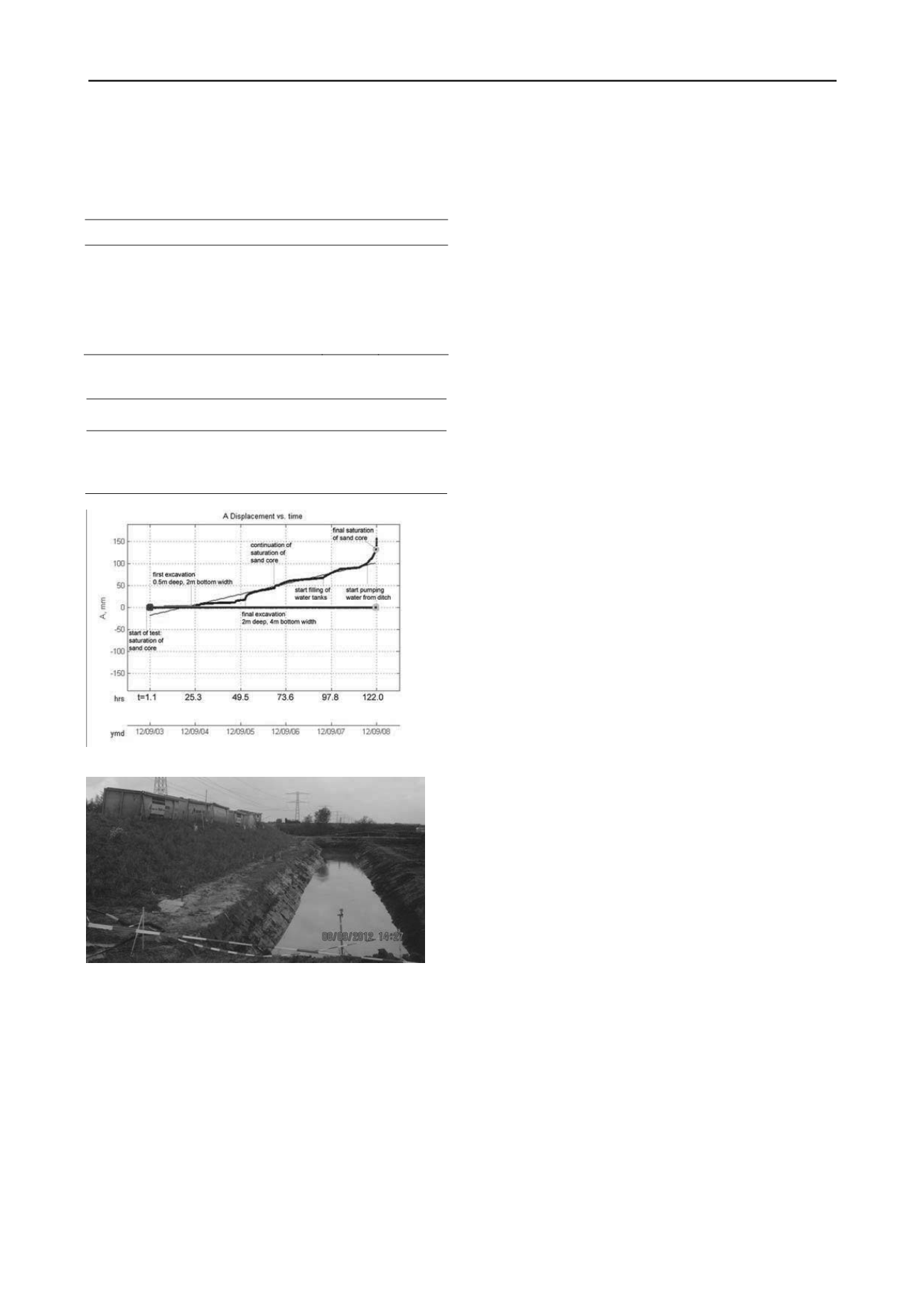
934
Proceedings of the 18
th
International Conference on Soil Mechanics and Geotechnical Engineering, Paris 2013
inclinometers except one at the East side, which failed. The pre-
set deformation criterion for a successful test was exceeded at
the moment the maximum pore pressures were recorded.
Table 1. Safety factors calculated for the South dike.
Situation, date, time
Van
Bishop
Dike completed, June 26, 5:00 pm
Start of test, Sept. 3, 12:12 pm
Before last excavation, Sept. 5, 9:00 am
After last excavation, Sept. 5, 5:00 pm
Start of last infiltration, Sept. 8,1:53 pm
Maximum pore pressures, Sept. 8, 2:13 pm
Visible failure, Sept. 8, 2:27 pm
1.46
1.74
1.24
1.05
1.01
0.92
0.94
1.50
1.82
1.38
1.08
1.05
0.95
0.98
Table 2. Horizontal deformations measured by inclinometers around
failure, in mm.
Time
East in
toe
Middle
- crest
Middle in
berm
West in
berm
West
in toe
1:53 pm
2:13 pm
2:27 pm
2:30 pm
115
145
180
225
145
190
430
1450
160
200
470
1650
140
175
310
900
135
155
320
830
Figure 6. Horizontal displacements at toe of dike until close to failure.
Figure 7. South dike during failure: fracturing of slope of ditch.
5 PERFORMANCE OF THE MONITORING SYSTEMS
All monitoring systems were judged by their accuracy, range,
density of measurements, measurement frequency, redundancy,
robustness, time to install and adjust, processing time,
interpretation and quality of prediction. Note that several of
these factors are not only influenced by the instrumentation, but
also by the strategy adopted by the company. It should also be
noted that successful application of any technique depends on
the actual conditions and environment.
An extensive evaluation of the results by the above criteria
indicated a good to excellent performance in these tests of the
controllable drainage tubes, the thermic infrared camera system
for piping and micro-instability (although faster processing of
the measurements seems, in general, a point of improvement),
the tubes measuring strain and temperature profiles (design
could be improved) and the ground based SAR (robustness to
field conditions could be improved). The other systems
performed as expected or worse.
6 PERFORMANCE OF THE INFORMATION SYSTEMS
The information systems were judged by their ability to
combine data of different sources, the application of various
techniques and methods to arrive at meaningful information, the
clarity of statements and the quality of prediction.
Two companies performed well, one employing advanced
data driven modelling and anomaly detection to improve finite
element calculations, the other one focused more on an
engineer’s approach employing both modern technology and
visual observations to update their predictions during the test.
The third company restricted its efforts mainly to producing
all kinds of graphical presentations of the measured data, but
hardly combining data of different sources.
7 CONCLUSIONS
Each of the three test dikes failed according to one of the
designed failure modes. Instrumentation of nine companies was
tested, indicating a novel technique to measure strain and
temperature, a thermic infrared camera system to detect piping
and micro-instability and fast ground based SAR as promising
new monitoring techniques, as well as a controllable drainage
tube capable of preventing failure. Employing monitoring data
led to an improvement of the prediction of failure, especially if
different types of monitoring were used. Real-time advanced
modelling further improves the knowledge on the actual and
expected condition of dikes.
8 ACKNOWLEDGEMENTS
Acknowledgements are made to Staatsbosbeheer for providing
the test site at Booneschans, the Dutch Ministry of Economic
Affairs, Agriculture and Innovation for the financial support and
all participating companies for their efforts.
9 REFERENCES
Beek, V.M. van, Knoeff, H. and Sellmeijer, H. 2011. Observations on
the process of backward erosion piping in small-, medium- and full-
scale experiments,
European Journal of Environmental and Civil
Engineering
15(8), 1115-1137.
Bishop, A.W. 1955. The use of the slip circle in the stability analysis of
slopes.
Géotechnique
5 (1), 7-17.
Burenkova, V.V. 1993. Assessment of suffusion in non-cohesive and
graded soils,
Filters in geotechnical and hydraulic engineering
,
Brauns, Heibaum, Schuler (editors), Balkema, Rotterdam, 357-360.
Groot, M. de, Mastbergen, D., Bezuijen, A. and Stoutjesdijk, T. 2011.
Micro-instability at dike inner slopes,
A feeling for soil and water.
A tribute to prof. Frans Barends,
Van, M., Haan, E. den and Deen,
J. van (editors), Deltares Select Series 07/2011, Delft, 65-74.
Koelewijn, A.R. and Bennett, V.G. 2012. Levee failure prediction
competition 2012, ijkdijk.rpi.edu.
Spencer, E. 1967. A method of analysis of the stability of embankments
assuming parallel inter-slice forces,
Géotechnique
17(1), 11-26.
Van, M.A. 2001. New approach for uplift induced slope failure,
Proc.
XVth Int. Conf. Soil Mech. Geot. Eng.,
Istanbul, 2285-2288.
Zwanenburg, C., Haan, E.J. den, Kruse, G.A.M. and Koelewijn, A.R.
2012. Failure of a trial embankment on peat in Booneschans, the
Netherlands.
Géotechnique
62 (6), 479-490.


